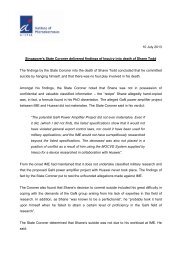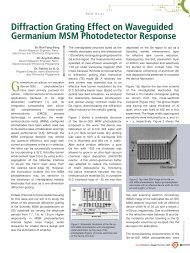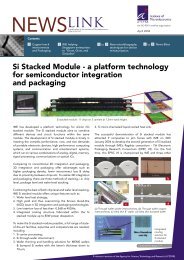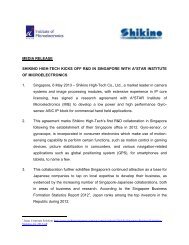taper couplers for coupling between laser and silicon waveguide ...
taper couplers for coupling between laser and silicon waveguide ...
taper couplers for coupling between laser and silicon waveguide ...
Create successful ePaper yourself
Turn your PDF publications into a flip-book with our unique Google optimized e-Paper software.
Zhang Jing, Li Bihan, Jayakrishnan Ch<strong>and</strong>rappan, Zhang Qing Xin,<br />
P V Ramana, Patinharek<strong>and</strong>y Prabhattan, John Lau, Kwong Dim Lee <strong>and</strong><br />
Murukeshan Vadakke Matham, “TAPER COUPLERS FOR COUPLING BETWEEN<br />
LASER AND SILICON WAVEGUIDE WITH LARGE ALLOWABLE TOLERANCE,”<br />
Photonics Packaging, Integration, <strong>and</strong> Interconnects VIII, edited by Alexei L. Glebov, Ray T. Chen<br />
Proc. of SPIE Vol. 6899, 689909, (2008) · 0277-786X/08/$18 · doi: 10.1117/12.764254<br />
Copyright 2009 Society of Photo-Optical Instrumentation Engineers. One print or electronic<br />
copy may be made <strong>for</strong> personal use only. Systematic electronic or print reproduction <strong>and</strong><br />
distribution, duplication of any material in this paper <strong>for</strong> a fee or <strong>for</strong> commercial purposes, or<br />
modification of the content of the paper are prohibited.<br />
http://dx.doi.org/10.1117/12.764254
TAPER COUPLERS FOR COUPLING BETWEEN LASER AND<br />
SILICON WAVEGUIDE WITH LARGE ALLOWABLE<br />
TOLERANCE<br />
Zhang Jing, Li Bihan 1 , Jayakrishnan Ch<strong>and</strong>rappan, Zhang Qing Xin, Pamidighantam V Ramana,<br />
Patinharek<strong>and</strong>y Prabhathan 2 , Lau Hon Shing, Kwong Dim Lee, Murukeshan Vadakke Matham 2<br />
Institute of Microelectronics, A*STAR (Agency <strong>for</strong> Science, Technology <strong>and</strong> Research),<br />
11 Science Park Road, Singapore Science Park II, Singapore 117685<br />
Tel: (65) 67705391, Fax: (65) 67745747<br />
zhangj@ime.a-star.edu.sg<br />
1 Attachment student from the National University of Singapore<br />
2 Nanyang Technological University, Singapore<br />
ABSTRACT<br />
A <strong>taper</strong> coupler with multimode input <strong>and</strong> single mode output is presented <strong>for</strong> <strong>coupling</strong> <strong>between</strong> edge emitting <strong>laser</strong><br />
diode <strong>and</strong> <strong>silicon</strong> <strong>waveguide</strong>. The <strong>taper</strong>ed coupler structure is optimized <strong>and</strong> tolerance <strong>for</strong> <strong>laser</strong> diode placement is<br />
studied. A typical <strong>coupling</strong> efficiency of -2dB is achieved from <strong>laser</strong> diode to <strong>silicon</strong> <strong>waveguide</strong>. With tolerance of +/-<br />
4µm laterally or vertically, the variation of the <strong>coupling</strong> efficiency is about 3dB. The tolerance is large compared with<br />
other methods. Tilting angle at <strong>laser</strong> diode <strong>and</strong> the small gap <strong>between</strong> <strong>taper</strong>ed coupler <strong>and</strong> <strong>silicon</strong> <strong>waveguide</strong> also affect<br />
the overall <strong>coupling</strong>. From our studies, horizontal <strong>and</strong> vertical offsets are more critical <strong>for</strong> <strong>laser</strong> diode placement in order<br />
to have a good <strong>coupling</strong>. The new design can be applied to photonics packaging because it will make passive assembly<br />
easier by having larger tolerance <strong>for</strong> packaging compared with the conventional method with lens.<br />
Keywords: Coupling efficiency, Laser diode attachment, Silicon <strong>waveguide</strong>, Taper coupler, Tolerance<br />
1. INTRODUCTION<br />
Silicon photonics attracts much attention in recent years. Waveguides, various passive optical components, <strong>and</strong> photo<br />
detectors have been realized <strong>and</strong> can be integrated on <strong>silicon</strong> using st<strong>and</strong>ard CMOS techniques. However, <strong>silicon</strong> <strong>laser</strong><br />
still has a long way to go. Presently, we still need to couple <strong>laser</strong> from an external <strong>laser</strong> source to <strong>silicon</strong> photonics<br />
devices. A typical DFB <strong>laser</strong> diode has a small beam spot at the output with wide divergence angles of horizontal 20<br />
degrees <strong>and</strong> vertical 40 degrees. A <strong>silicon</strong> <strong>waveguide</strong> is about 0.35µm (height) * 0.4µm (width). Compared with <strong>laser</strong><br />
diode to single mode fiber <strong>coupling</strong> [1][2], optical <strong>coupling</strong> <strong>between</strong> <strong>laser</strong> diode to <strong>waveguide</strong> is even more challenging.<br />
Direct <strong>coupling</strong> (butt <strong>coupling</strong>) will have large loss. Coupling with focusing lenses of different mechanisms is intolerant<br />
of small misalignment (0.5µm) <strong>between</strong> the <strong>laser</strong> <strong>and</strong> <strong>waveguide</strong> tip. M. Oguro et al from NEC used mode size converter<br />
to couple light from <strong>laser</strong> diode to a 4.5µm (height) * 8µm (width) planar <strong>waveguide</strong> with 6.5dB <strong>coupling</strong> loss [3].<br />
Bookham claimed a <strong>taper</strong>ed rib <strong>waveguide</strong> to transit light from relatively large cross-section <strong>waveguide</strong>, eg. fiber, to a<br />
smaller cross-section <strong>waveguide</strong> [4]. In this paper, we propose a <strong>taper</strong> coupler with larger tolerance (+/-3µm) with good<br />
<strong>coupling</strong> efficiency (≥-3dB to -6dB) <strong>for</strong> <strong>laser</strong> <strong>and</strong> <strong>silicon</strong> <strong>waveguide</strong> <strong>coupling</strong>. Rather than the adiabatic mode size<br />
converter, it starts with an input size larger than the mode size of <strong>laser</strong> diode. Because of the larger input size, the light<br />
can be coupled into the <strong>taper</strong> structure with larger tolerances. The design is optimized <strong>and</strong> tolerance is studied.<br />
2. TAPER COUPLER DESIGN AND SIMULATION FOR LASER AND SILICON<br />
WAVEGUIDE COUPLING<br />
A <strong>taper</strong> coupler with mode size matching at both sides will convert the mode from one <strong>waveguide</strong> to another <strong>waveguide</strong>.<br />
But the mode size converter needs to be aligned with the both the <strong>waveguide</strong>s precisely, as otherwise, most of the light<br />
Photonics Packaging, Integration, <strong>and</strong> Interconnects VIII, edited by Alexei L. Glebov, Ray T. Chen<br />
Proc. of SPIE Vol. 6899, 689909, (2008) · 0277-786X/08/$18 · doi: 10.1117/12.764254<br />
Proc. of SPIE Vol. 6899 689909-1
will be lost [5][6]. In order to achieve a more generous tolerance <strong>for</strong> passive alignment in low cost assembly, a <strong>taper</strong><br />
coupler with relative large input opening is designed to couple the light from <strong>laser</strong> diode to <strong>silicon</strong> <strong>waveguide</strong>. In order<br />
to make the fabrication simpler, the coupler is designed to have symmetric lateral <strong>taper</strong> <strong>and</strong> pseudo-vertical <strong>taper</strong> shape.<br />
The <strong>laser</strong> diode active <strong>waveguide</strong> faces the center of the entrance facet of <strong>taper</strong> coupler. Figure 1 <strong>and</strong> figure 2 show the<br />
top view <strong>and</strong> cross-sectional views of the designed <strong>taper</strong>ed coupler structure.<br />
The design of the coupler includes considerations of assembly. Considering the placement of <strong>laser</strong> diode will be at least<br />
a distance from the <strong>taper</strong> coupler, the <strong>laser</strong> beam will diverge to a beam spot of several micrometers diameter. Thus, we<br />
designed the opening at input side to be 12µm*12µm which is larger than the <strong>laser</strong> diode mode size. Considering the<br />
divergence angle of 32 degree, the distance <strong>between</strong> the <strong>laser</strong> diode <strong>and</strong> the <strong>taper</strong> coupler should be less than 21um. This<br />
helps in <strong>coupling</strong> the light into the coupler even if the <strong>laser</strong> diode has a few micrometers displacement. The designed<br />
<strong>taper</strong> <strong>waveguide</strong> has a core refractive index of 1.51 <strong>and</strong> clad refractive index of 1.46. This results in a multi modal<br />
<strong>taper</strong>ed coupler. Higher order modes will be lost during the propagation through the coupler. However, most of the light<br />
will be coupled into the <strong>waveguide</strong> by design optimization. The <strong>taper</strong> coupler has two layers to <strong>for</strong>m the pseudo-vertical<br />
<strong>taper</strong>ing structure as depicted in figure 2. The bottom layer is 11µm thick <strong>and</strong> top layer is 1µm thick. The length of the<br />
bottom layer is optimized so that most of the light will be coupled into the top layer. The output end of the <strong>taper</strong> coupler<br />
<strong>taper</strong>s down to 1µm*1µm whose fundamental mode matches with propagation constant of the mode in <strong>silicon</strong><br />
<strong>waveguide</strong>. The length of the coupler is 1.7mm. The length of the top layer is optimized to achieve the best <strong>coupling</strong><br />
<strong>between</strong> the <strong>taper</strong> coupler <strong>and</strong> <strong>silicon</strong> <strong>waveguide</strong>. Figure 3 shows the horizontal light propagation from <strong>laser</strong> diode to a<br />
<strong>silicon</strong> <strong>waveguide</strong> through <strong>taper</strong> coupler. Figure 4 shows the vertical light propagation. By using such a <strong>taper</strong> coupler, a<br />
typical -2dB <strong>coupling</strong> efficiency is achieved.<br />
Laser diode<br />
Silicon Optical Bench - Top View<br />
Silicon <strong>waveguide</strong><br />
Active <strong>waveguide</strong><br />
Taper Coupler<br />
Fig. 1 Top view of a <strong>taper</strong> coupler <strong>between</strong> <strong>laser</strong> diode <strong>and</strong> <strong>silicon</strong> <strong>waveguide</strong>.<br />
Laser diode<br />
Active <strong>waveguide</strong><br />
Taper Coupler<br />
Silicon <strong>waveguide</strong><br />
Silicon Optical Bench - Side View<br />
Fig. 2 Side view of a <strong>taper</strong> coupler <strong>between</strong> <strong>laser</strong> diode <strong>and</strong> <strong>silicon</strong> <strong>waveguide</strong>.<br />
Proc. of SPIE Vol. 6899 689909-2
Laser diode<br />
<strong>waveguide</strong><br />
Fig. 3 Light propagation from <strong>laser</strong> diode to <strong>silicon</strong> <strong>waveguide</strong> through <strong>taper</strong> coupler (horizontal slice).<br />
Fig. 4 Light propagation from <strong>laser</strong> diode to <strong>silicon</strong> <strong>waveguide</strong> through <strong>taper</strong> coupler (vertical slice).<br />
3. LASER DIODE TOLERANCE STUDY DURING DESIGN<br />
To study the possible tolerance values of <strong>laser</strong> diode placement, simulation studies were carried out by shifting the input<br />
to the <strong>taper</strong>ed coupler in both horizontal <strong>and</strong> vertical positions. The placement tolerances were studied from -4µm to<br />
+4µm offset laterally <strong>and</strong> from -4µm to +4µm vertically. The <strong>coupling</strong> efficiency varies from -1.9dB to -5dB within +/-<br />
4µm lateral offset (Fig. 5), which means the variation is about 3dB. Figure 6 shows the light propagation in the <strong>taper</strong>ed<br />
coupler when the <strong>laser</strong> diode is offset by 4µm laterally. The <strong>coupling</strong> variation is less than 3dB when the vertical<br />
position of the <strong>laser</strong> <strong>waveguide</strong> offsets from –4µm to +4µm (Fig. 7). In these two sets of simulations, we assume there is<br />
not tilting at the active <strong>waveguide</strong> of <strong>laser</strong> diode relative to the optical axis of <strong>taper</strong> coupler <strong>and</strong> <strong>silicon</strong> <strong>waveguide</strong>.<br />
Coupling efficiency (dB)<br />
0<br />
-1<br />
-2<br />
-3<br />
-4<br />
-5<br />
-6<br />
-5 -4 -3 -2 -1 0 1 2 3 4 5<br />
Lateral offset (µm)<br />
Fig. 5 Coupling efficiency vs. lateral offset.<br />
Proc. of SPIE Vol. 6899 689909-3
Laser diode<br />
<strong>waveguide</strong><br />
Fig. 6 Light propagation from <strong>laser</strong> diode to <strong>silicon</strong> <strong>waveguide</strong> through <strong>taper</strong> coupler with 4 µm horizontal<br />
offset.<br />
Coupling efficiency (dB)<br />
Fig. 7 Coupling efficiency vs. vertical offset.<br />
0<br />
-1<br />
-2<br />
-3<br />
-4<br />
-5<br />
-6<br />
-4 -3 -2 -1 0 1 2 3 4<br />
Vertical offset (µm)<br />
It’s also possible that the <strong>laser</strong> diode is tilted relative to the optical axis of <strong>taper</strong>ed coupler <strong>and</strong> <strong>silicon</strong> <strong>waveguide</strong>. The<br />
<strong>coupling</strong> property at tilting condition is studied. The schematic configuration of tilting <strong>between</strong> <strong>laser</strong> diode <strong>and</strong> coupler<br />
is shown in Fig. 8. The <strong>coupling</strong> efficiency results over a range of tilting angle are presented in Fig. 9. When there is a<br />
deliberate tilt of +/-2 degrees, the <strong>coupling</strong> efficiency improves from -1.9dB to -2.8dB. Hence, the <strong>coupling</strong> efficiency<br />
variation due to tilting of <strong>laser</strong> diode is less than 1dB. Figure 10 shows the light propagation from <strong>laser</strong> diode to <strong>silicon</strong><br />
<strong>waveguide</strong> through <strong>taper</strong> coupler with 2 degree tilting at <strong>laser</strong> diode. It can be seen that the modes are launched<br />
asymmetrically in <strong>taper</strong>ed coupler. The light propagation is very similar to horizontal offset of <strong>laser</strong> diode.<br />
Laser diode<br />
Silicon Optical Bench<br />
Top View<br />
θ<br />
Taper Coupler<br />
Active<br />
<strong>waveguide</strong><br />
Fig. 8 Top view of a <strong>taper</strong> coupler <strong>between</strong> a lateral tilting <strong>laser</strong> diode <strong>and</strong> <strong>silicon</strong> <strong>waveguide</strong>.<br />
Proc. of SPIE Vol. 6899 689909-4
-1<br />
-1.5<br />
Coupling efficiency (dB)<br />
-2<br />
-2.5<br />
-3<br />
-3.5<br />
-3 -2 -1 0 1 2 3<br />
Tilting angle (degree)<br />
Fig. 9 Coupling efficiency vs. lateral tilting angle.<br />
Laser diode<br />
<strong>waveguide</strong><br />
Fig. 10 Light propagation from <strong>laser</strong> diode to <strong>silicon</strong> <strong>waveguide</strong> through <strong>taper</strong> coupler with 2 degree tilting.<br />
4. CONCLUSIONS<br />
In this paper a coupler is designed <strong>for</strong> <strong>coupling</strong> the light from <strong>laser</strong> diode to <strong>silicon</strong> <strong>waveguide</strong> with large alignment<br />
tolerances. The coupler has a pseudo vertical <strong>taper</strong>ed structure. Laterally, it has a linear <strong>taper</strong>. The input aperture is much<br />
larger than the size of the <strong>laser</strong> <strong>waveguide</strong> cross-section. The <strong>taper</strong>ed coupler provides single mode output <strong>and</strong> matches<br />
the mode propagation constant with that in <strong>silicon</strong> <strong>waveguide</strong>. The <strong>taper</strong>ed coupler is fabricated on the same substrate<br />
with the <strong>silicon</strong> <strong>waveguide</strong> through the <strong>silicon</strong> micro-fabrication process. The misalignment <strong>between</strong> the <strong>silicon</strong><br />
<strong>waveguide</strong> <strong>and</strong> <strong>taper</strong> coupler can be very small since this is controlled by high precision <strong>silicon</strong> optical bench patterning<br />
processes. The coupler relaxes the <strong>laser</strong> diode placement accuracies <strong>and</strong> eliminates the need <strong>for</strong> a <strong>coupling</strong> lens. Design<br />
Studies showed that the tolerance <strong>between</strong> the <strong>laser</strong> diode <strong>and</strong> <strong>taper</strong> coupler can be more than +/-4µm misalignment at x-<br />
y, <strong>and</strong> more than +/-2 degree tilting angle tolerance. The <strong>laser</strong> to <strong>silicon</strong> <strong>waveguide</strong> <strong>coupling</strong> tolerances is greatly<br />
improved <strong>and</strong> passive alignment <strong>for</strong> <strong>laser</strong> diode <strong>and</strong> <strong>silicon</strong> <strong>waveguide</strong> becomes possible. The technology is suitable <strong>for</strong><br />
functional integration <strong>for</strong> <strong>silicon</strong> photonics. Important results are summarized as followings:<br />
1. A <strong>taper</strong> coupler is designed <strong>for</strong> larger tolerance <strong>laser</strong> diode <strong>and</strong> <strong>silicon</strong> <strong>waveguide</strong> light <strong>coupling</strong>;<br />
2. The optimized structure can achieve -2dB <strong>coupling</strong> efficiency by simulation;<br />
3. With +/-4µm <strong>laser</strong> diode offset, the <strong>coupling</strong> efficiency varies only 3dB;<br />
4. +/-2 degree tilting at the <strong>laser</strong> diode varies the <strong>coupling</strong> efficiency by only 1dB.<br />
Proc. of SPIE Vol. 6899 689909-5
5. ACKNOWLEDGEMENTS<br />
The authors wish to express their gratitude to the IME management <strong>and</strong> staff of SPT <strong>and</strong> MMC labs <strong>for</strong> their support in<br />
fabrication <strong>and</strong> assembly. The authors would also like to express their gratitude to Assoc Prof Franck Chollet, School of<br />
Mechanical <strong>and</strong> Aerospace Division, Nanyang Technological University (NTU), Singapore <strong>for</strong> the useful discussions<br />
during the work. Special thanks go to Bryan Lee Sik Pong, Dr. Lim Teck Guan <strong>and</strong> Dr. Tan Chee Wei <strong>for</strong> their support<br />
<strong>and</strong> help.<br />
6. REFERENCES<br />
1. US patent 0259918, “Optical fiber coupler having a relaxed alignment tolerance”, 2005.<br />
2. US patent 0045423, “Diffractive coupler optimized <strong>for</strong> alignment tolerances”, 2006.<br />
3. M. Oguro, et al., “1.25Gb/s WDM bidirectional transceiver module using DFB-LD <strong>and</strong> PLC with spot-size<br />
conversion region”, IEEE ECTC 2002, 305-310 (2002).<br />
4. US patent 6108478,“Tapered rib <strong>waveguide</strong>”.<br />
5. US patent 007088890B2, “Dual “cheese wedge” <strong>silicon</strong> <strong>taper</strong> <strong>waveguide</strong>”, 2006.<br />
6. J. H. Schmid, et al., “Mode converters <strong>for</strong> <strong>coupling</strong> to high aspect ratio <strong>silicon</strong>-on-insulator channel<br />
<strong>waveguide</strong>s”, IEEE Photonics technology letters, Vol. 19, No. 11, pp. 855-857 (2007).<br />
Proc. of SPIE Vol. 6899 689909-6













